| A | B |
|---|
| Newton's first law of motion states that "An object in motion (or at rest) will stay in the same motion (or at rest) unless acted on by an _________________. " | unbalanced force |
| According to Newton's 1st Law of Motion, a rocket in space that runs out of fuel will _____. | keep going in the same direction at the same speed as when it ran out of fuel. |
| A rocket is accelerating in space due to it's engine applying a force of 1000 Newtons. At the moment it hits a speed of 10,000 km/hr, the reverse thrusters go on and also apply a force of 1000 Newtons. Two engines are now firing but in opposite directions with equal force. If it took the rocket 1 hour to get up to the speed of 10,000 km/hr starting at a dead standstill, what will the rocket's speed be an hour after the reverse thrusters go on? | 10,000 km/hr (Since the two engines cancel each other out, it won't be any different than if the reverse thruster never went on and the rocket's main engine just turned off. Without an unbalanced force, the rocket will just keep going in the same direction and the same speed) |
| TRUE or FALSE: A satellite stays in orbit and doesn't accelerate toward Earth because there is no force of gravity on it. | FALSE (If there were no force of gravity on the rocket, it would just fly off in a straight line and drift away from Earth. The satellite is actually always accelerating toward Earth but because it is also moving very fast, it never gets closer to Earth), 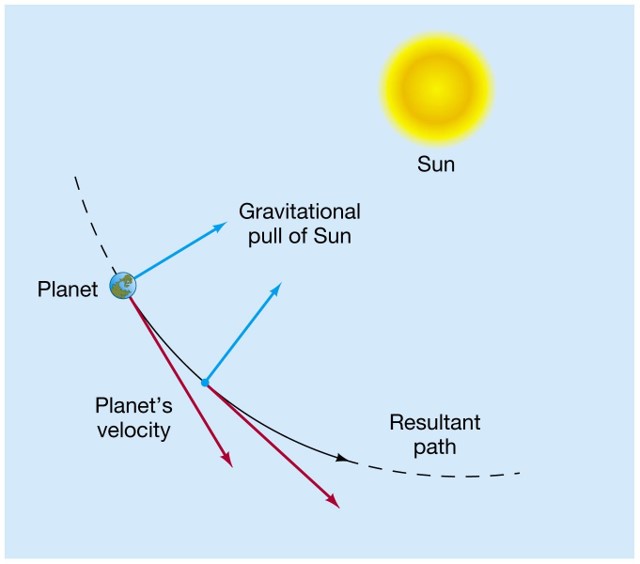 |
| Newon's 2nd Law states that Force = _______. | mass X acceleration |
| Based on Newton's 2nd Law, the acceleration of an object = the force applied to the object _____ the mass of the object. | divided by |
| The acceleration of gravity within a few miles of Earth's surface is 10m/s^2 (10 meters per second squared). If you drop a bowling ball out of an airplane, how fast will it be going 5 seconds later? | 50 meters per second squared (Remember, having if something accelerates at a rate of 10 meters per second squared, that means its velocity is increasing by 10 meters per second every second. After 1 second, it will be going 10 meters per second. After 2 seconds, it will be going 20 meters per second. After 3 seconds, 30 meters per second, and so on and so on.) |
| TRUE or FALSE: If you drop a feather and a bowling ball on the moon where there is no atmosphere to slow things down, the feather and the bowling ball would accelerate at the same rate and hit the surface of the moon at the same time. | TRUE (The acceleration of gravity is constant near the surface of any planet or moon. Although the acceleration of gravity is much less on the moon than on the Earth, just like the Earth it will cause any object, no matter what its mass to accelerate at the same rate as it falls, as long as there is no air resistance) |
| If a rocket engine is applying a constant force to a rocket, the rocket will move a a constant speed. | FALSE (Since there is a force, there will be an acceleration and the rocket will go faster and faster according to Newton's 2nd Law which is Force = mass X acceleration. If it was going at a constant speed, it wouldn't be accelerating, and if the acceleration is zero, then the force would also have to be zero, but it's not.) |
| An object that has a mass of 1 kilogram at Earth's surface weighs 2.2 lbs (pounds). In deep space, what would the mass be? | 1 kg (mass never changes) |
| An object that has a mass of 1 kilogram at Earth's surface weighs 2.2 lbs (pounds). In deep space, what would the weight be? | zero pounds (Mass and weight are not the same things. Weight is a measurement of force and it depends on the acceleration of gravity X the mass of the object. The mass of the object is still 1 kg, but since the acceleration of gravity is zero in deep space, the weight is also zero) |
| Newton's 3rd Law states that "For every action, there is ____. | an equal and opposite reaction |
| TRUE or FALSE: If you pull on a rope attached to brick wall with a force of 500 N, the brick wall will pull on you with a force of 500 N. | TRUE (According to Newton's 3rd Law, for every action there is an equal and opposite reaction, so if you pull on a rope attached to a brick wall with a force of 500N, then there must be a force of 500N pulling on you in the opposite direction. That force on you is being applied by the wall), 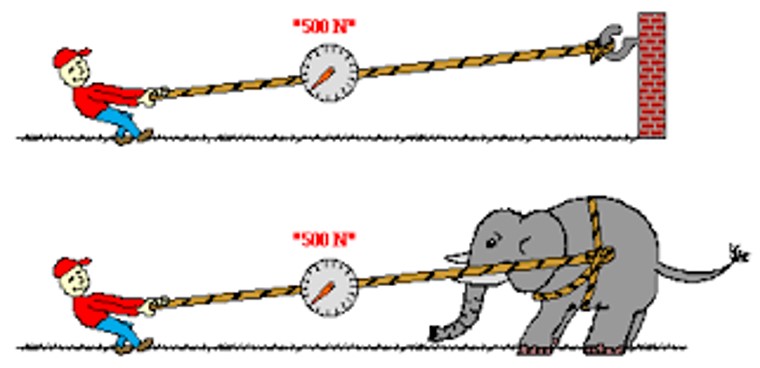 |
Look at the picture of the two people on skateboards below. If they put their hands up against each other and both push, who moves backwards faster will depend on ______., 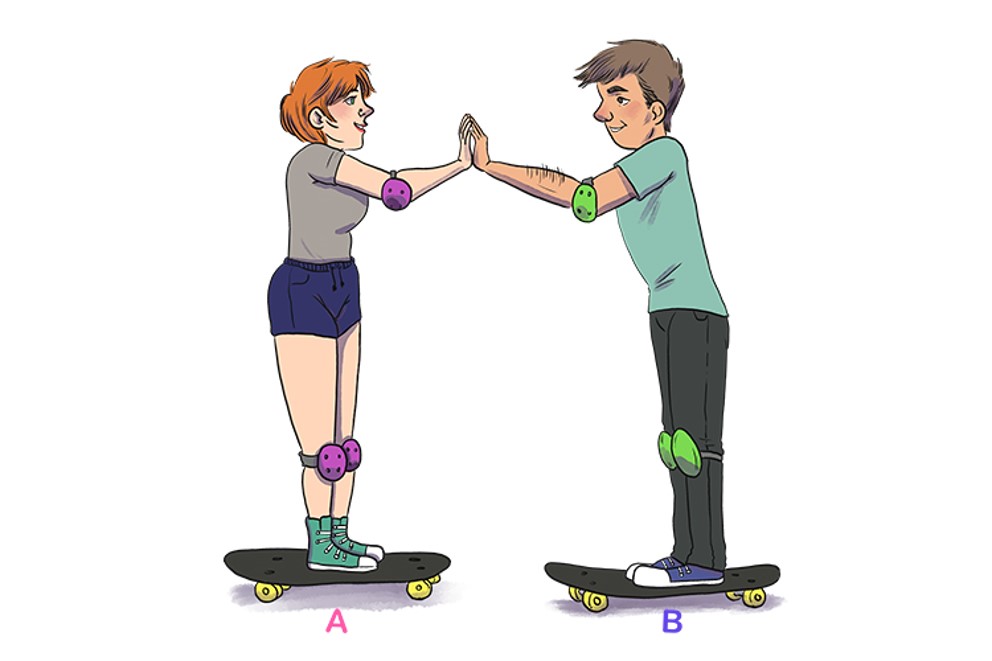 | who is lighter OR who has less mass (Since the force between their hands will be equal and opposite when they push, their acceleration will equal that force divided by their mass. Whoever is more massive will accelerate more slowly. The person who accelerates more quickly will be going faster when their hands come apart),  |
| TRUE or FALSE: The first rockets were developed to kill people. | TRUE (Rockets were developed for battle, dating all the way back to 1232 when China used rocket propelled arrows to fight the Mongolians. They've been use for military purposes ever since, including the German V-2 which was used in World War 2 and also became the first rocket to make it into space) |
| Which year did the first man land on the moon and what nation put him there? | 1969, the United States |
| TRUE or FALSE: As of 2023, the United States is the only country to have landed astronauts on the moon. | TRUE, 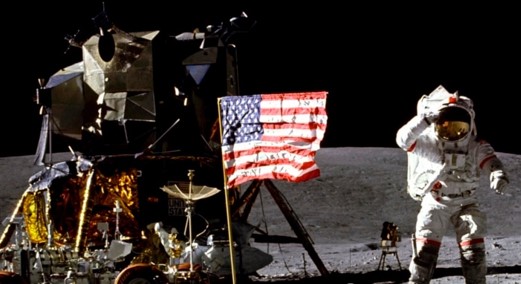 |
| TRUE or FALSE: As of 2023, no human has walked on the moon since 1972. | TRUE (but there are plans to go back by the middle of this decade) |
| TRUE or FALSE: The United States was the first country to put a satellite into orbit. | FALSE (The Soviet Union put the first satellite, named Sputnik, into orbit in 1957. This caused much alarm for the United States and started the Space Race with the Soviets and the Cold War) |
| TRUE or FALSE: The United States was the first country to put a human into space. | FALSE (The Soviet Union became the first country to put a human into space and into orbit when cosmonaut Yuri Gagarin, reached space and circled the Earth in 1961) |
| According to Newton's 3rd Law, if there is a force pushing a rocket in one direction, what is the equal and opposite force being applied to in the other direction? | the exhaust gases (being shot out the nozzle of the rocket engine in the opposite direction), 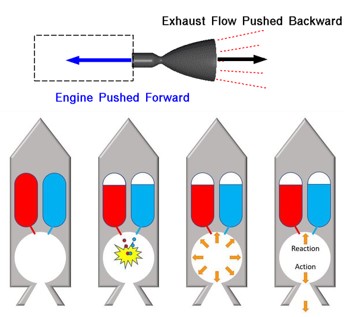 |
The huge Saturn V rocket that boosted the Apollo missions out of Earth's atmosphere and into space used hydrogen and oxygen as rocket fuel. What chemical was coming out of the rocket engine as the hydrogen burned?, 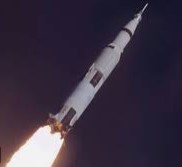 | Water (in the form of water vapor, which is still H2O. The chemical reaction that caused the thrust is 2H2 + O2 --> 2H2O) ** The 2's that come after a letter are supposed to be subscripts),  |
| TRUE or FALSE: Every planet in our solar system has been visited by an unmanned space-probe. | TRUE (Only Mars and Venus, our moon, and Saturn's moon Titan have been landed on, but all have been seen up close by space-probes) |
| The United States has plans to send astronauts back to the moon for the first time since 1972. | TRUE (There is a mission to fly astronauts around the moon in 2024 and to land on the moon shortly there after) |
| If life is found on another planet, which life form on Earth is it most likely to resemble the most? | Bacteria (If you could go into a time machine and transport yourself back in time to some random time, you would most likely find that the only life on Earth is bacteria because they've been around twice as long as any other type of life, dating back to over 3.5 billion years ago) |
| TRUE or FALSE: Some bacteria can survive in boiling water. | TRUE (There are bacteria that have evolved to survive near deep sea volcanic vents where the temperature is hot enough to boil water. Astrobiologists think that if there are bacteria that can survive those conditions, then there might be life on one of Jupiter's or Saturn's moons that have an icy surface but also volcanic activity that would melt at least some of that water) |
| Organisms (mostly bacteria) that can survive really harsh conditions like boiling water near deep sea volcanoes, or the frozen tundra of Antarctica, are called ________. | extremophiles (the suffix "-phile" means "loving." Extremophiles are organisms that "love" living in extreme habitats. Actually, they probably don't love it, but there's less competition for those habitats) |
| Which element do scientists think will be the backbone of molecules that make up alien life-forms, if we ever find any? | carbon (Every living thing on Earth is made of organic molecules with carbon as the backbone of the molecules. It has unique chemical properties that make it extremely suitable for forming "bio-molecules," which are molecules that make up living things. That is why astrobiologists think that alien life forms will be carbon-based too) |
| The branch of biology that studies the possibility of life in other places in the universe is called _____) | astrobiology |
| Which molecule do astrobiologists think must be present on any planet or moon where life might exist? | Water (water provides an ideal medium for chemical reactions by acting as a solvent. Most chemical reactions occur in an "aqueous" environment with the reactants being dissolved in water) |
| Astrobiologists believe that life on other planets (or moons) will require relatively _______ environments. | stable |
| Astrobiologists believe that planets or moons that contain life must have temperatures that allow water to exist _______. | in the liquid form (as opposed to the solid form "ice" or the gaseous form "vapor.") |
| Two things that could help an exoplanet keep stable enough temperatures for life to exist would be the presence of a(n) ______ and/or a(n) ______. | atmosphere with greenhouse gases, large liquid ocean |
| What is the main reason Astrobiologists look for life around stars that are the size of our Sun or smaller? | The smaller stars can last long enough for to evolve (Bigger ones burn out too fast. It took almost 1 billion years for life to first evolve on Earth) |
| TRUE or FALSE: Exoplanets are only found outside of our solar system. | TRUE (That's the definition of an exoplanet) |
| TRUE or FALSE: Planets have been seen and photographed orbiting other stars. | TRUE (A small number of very large exoplanets orbiting nearby stars are big enough to be seen through our most powerful telescopes. However, most of the exoplanets we've discovered have been discovered using other methods) |
| If a star appears to wobble, it is sign that it has ______. | exoplanets (Stars make planets go in ellipses around them, but planets also have a slight tug on stars which causes them to move in tiny circles <actually, ellipses, that make the star appear to wobble), 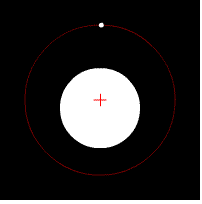 |
| In order to take a photograph of an exoplanet, what must be blocked out? | The light from the star it is orbiting (Otherwise the planet can't be seen because of the brightness of the star. There's a good animation of this at https://exoplanets.nasa.gov/resources/2286/direct-imaging/ Notice in the picture below that you can see several exoplanets but the light from the star in the center has been blocked out)), 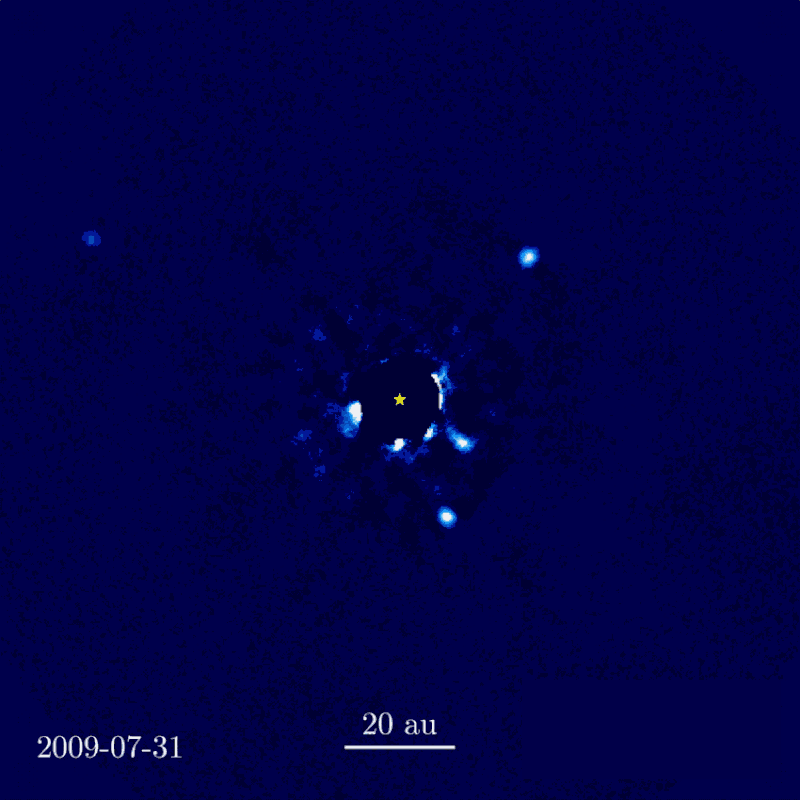 |
A star with an exoplanet will move in small circles (a wobble) because of the pull of gravity from the exoplanet. When the star is moving away from us, its light will be ____ - shifted., 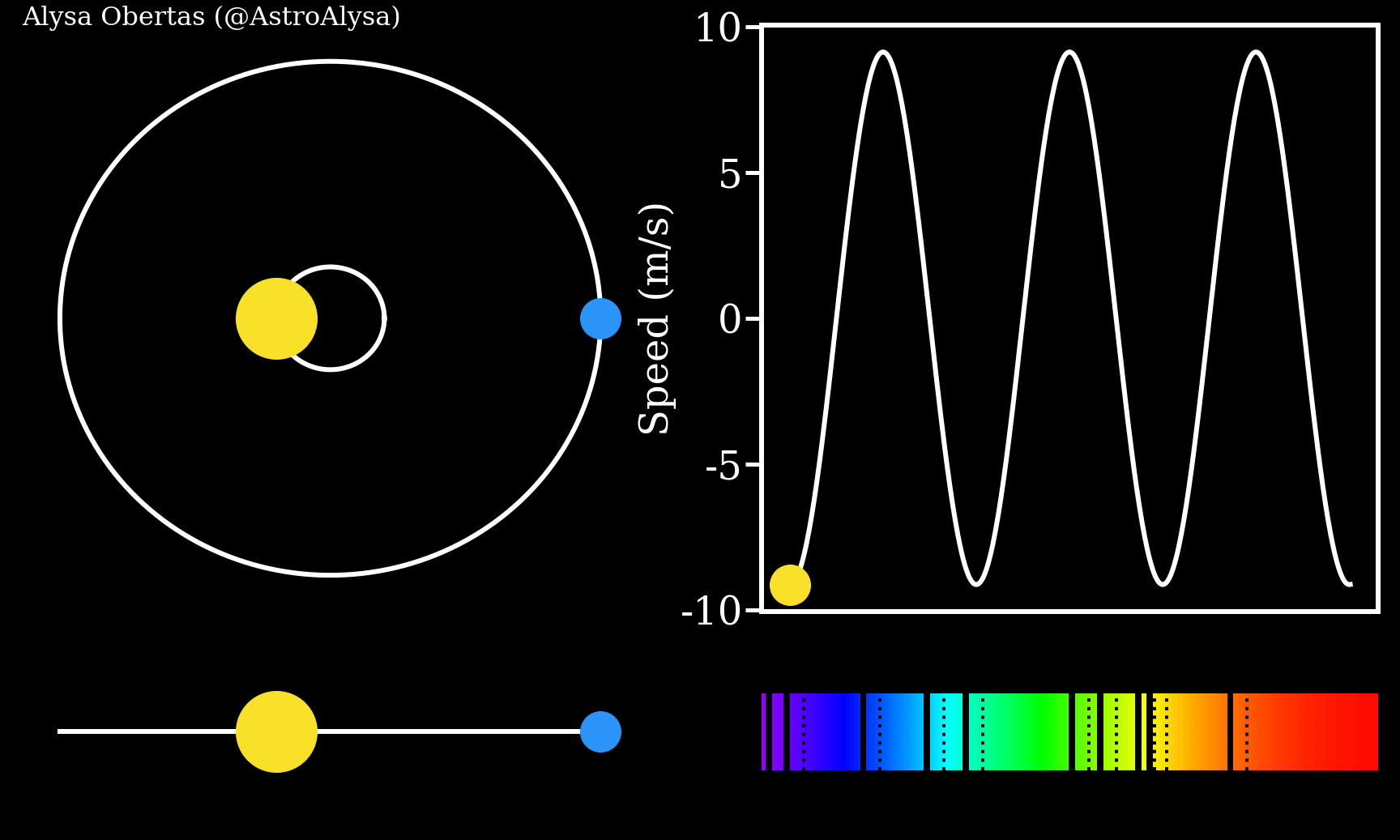 | red, 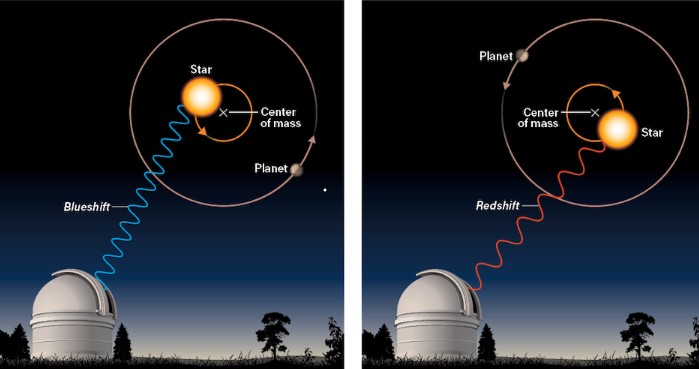 |
A star with an exoplanet will move in small circles (a wobble) because of the pull of gravity from the exoplanet. When the star is moving toward us, its light will be ____ - shifted.,  | blue,  |
A telescope points at a star and measures the amount of light coming from the star. It's pretty steady most of the time, but periodically, it drops as shown in the graph below (see point 3). A likely explanation is that a(n) _______is ________ the star., 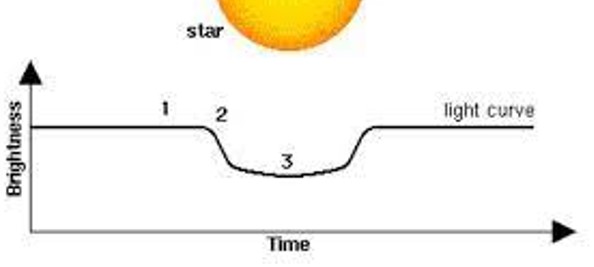 | exoplanet, in front of, 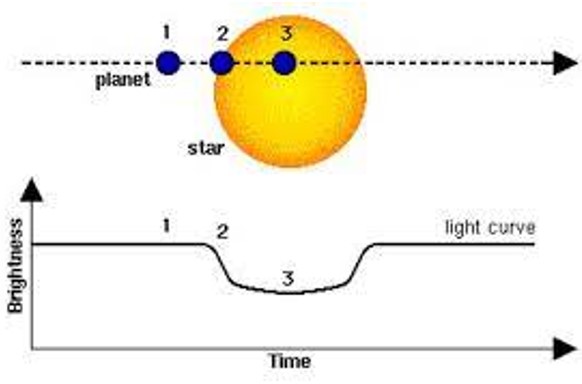 |
A telescope points at a star and measures the amount of light coming from the star. A graph of the intensity of light over time is shown below. The spike upward showing the star looking brighter is caused by light being bent and focused toward Earth making it brighter. What is the most likely explanation for this?, 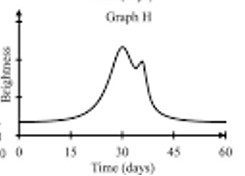 | A star going in front of a bigger star caused the first spike due to it's gravity while the gravity from an exoplanet caused the second smaller spike (Below is a good animation of how an object with gravity bends light to make it look brighter), 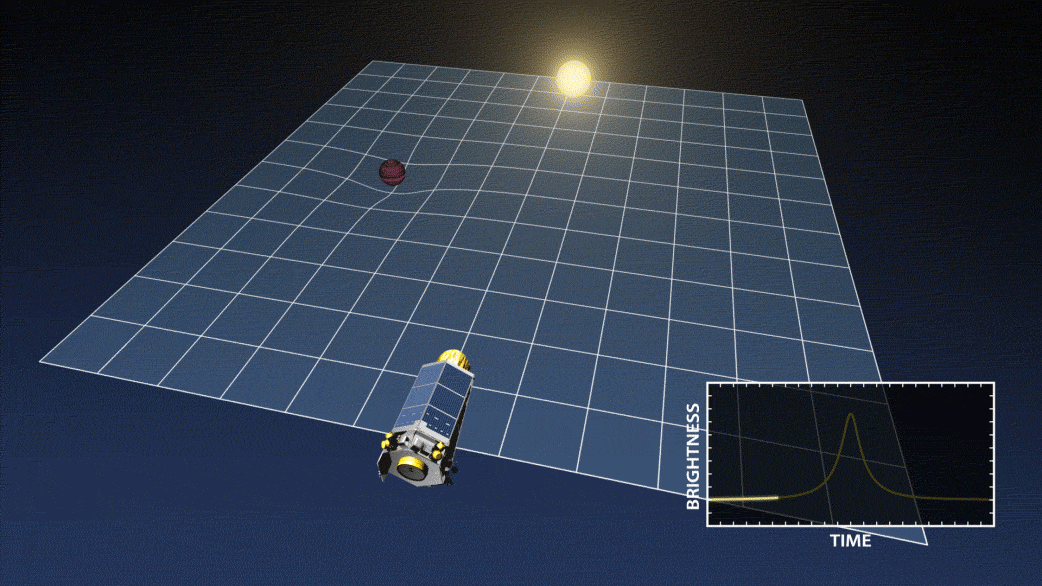 |
| Where is the most likely place to find life elsewhere in our solar system? | Mars (We know it had flowing water at one point because of the canyons that have been carved on Mars. So there must have been water and signs of liquid water can still be detected underground. Water is thought to be necessary for life. We just need to start digging.), 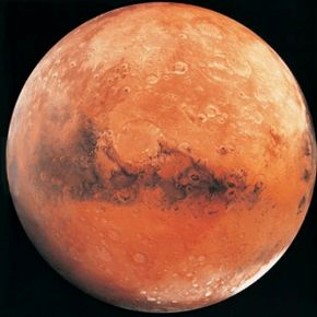 |
| Two planets that have moons which might have life include _______ with its moon Europa and ______ with its moon Enceledus, both of which are thought to have liquid oceans under their icy surfaces. | Jupiter, Saturn (Below is an infographic on how life might exist on Jupiter's moon Europa), 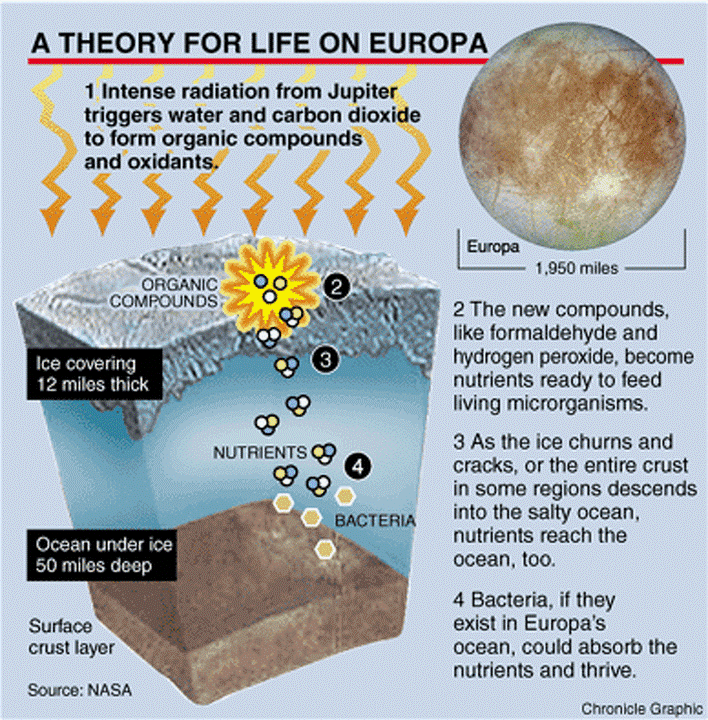 |
| Astrobiologists are monitoring for communications coming from advanced alien life forms mostly in the form of incoming ______ signals. | radio |